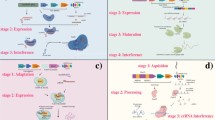Abstract
Alternative selection systems for plant transformation are especially valuable in clonal crops, such as potato (Solanum tuberosum L.), to pyramid transgenes into the same cultivar by successive transformation events. We have modified the pGPTV series of binary vectors to construct pMOA1 to pMOA5, resulting in a series of essentially identical binary vectors except for the presence of different selectable marker genes. These selectable marker genes are tightly inserted between the left and right T-DNA borders and confer resistance to kanamycin (nptII), hygromycin (hpt), methotrexate (dhfr), phosphinothricin (bar), or phleomycin (ble). The T-DNA of all the vectors is based on the minimal features necessary for plant transformation, with no extraneous DNA segments that may be unacceptable to regulatory authorities for general release of transgenic plants. A series of unique restriction sites exists between the right border and each selectable marker gene for subsequent insertion of useful genes. We have also developed improved culture procedures for potato transformation and used the pMOA1 to pMOA5 binary vectors to define stringent selection conditions for each marker gene. Combining these advances improved the frequency of recovering transformed potato plants while maintaining a low frequency of escapes. The relative efficiency of recovering transgenic potato lines with each selectable marker gene can be summarised as: kanamycin resistance>hygromycin resistance>phosphinothricin resistance>phleomycin resistance>methotrexate resistance.
Similar content being viewed by others
References
Becker D, Kemper E, Schell J & Masterson R (1992) New plant binary vectors with selectable markers located proximal to the left T-DNA border. Plant Mol. Biol. 29: 1195–1197
Bevan M (1984) Binary vectors for plant transformation. Nucleic Acids Res. 12: 8711–8721
Conner AJ (1986) Isolation and characterisation of variants from plant cell culture. NZ J. Technol. 2: 83–94
Conner AJ & Christey MC (1994) Plant breeding and seed marketing options for the introduction of transgenic insect-resistant crops. Biocontrol Sci. Technol. 4: 463–473
Conner AJ & Jacobs JME (1999) Genetic engineering of crops as a potential source of genetic hazard in the human diet. Mut. Res. 443: 223–234
Conner AJ, Williams MK, Gardner RC, Deroles SC, Shaw ML & Lancaster JE (1991) Agrobacterium-mediated transformation of New Zealand potato cultivars. NZ J. Crop Hort. Sci. 19: 1–8
Conner AJ, Jacobs JME & Genet RA (1997) Transgenic potatoes versus ‘traditional’ potatoes: what's the difference? In: McLean GD, Waterhouse PM, Evans G & Gibbs MJ (eds) Commercialisation of Transgenic Crops: Risk, benefit and trade considerations (pp 23–36). Cooperative Research Centre for Plant Science and Bureau of Resource Sciences, Canberra
El-Kharbotly A, Jacobs JME, te Lintel Hekkert B, Jacobsen E, Ramanna MS, Stiekema WJ & Pereira A (1996) Localization of Ds-transposon containing T-DNA inserts in the diploid transgenic potato: linkage to the R1 resistance gene against Phytophthora infestans (Mont.) de Bary. Genome 39: 249–257
Enckevort LJG van, Bergervoet JEM, Stiekema WJ, Pereira A & Jacobsen E (2000) Selection of independent Ds transposon insertions in somatic tissue of potato by protoplast regeneration. Theor. Appl. Genet. 101: 503–510
Haldrup A, Peterson SG & Okkels FT (1998a) The xylose isomerase gene from Thermoanaerobacterium thermosulfurogenes allows effective selection of transgenic plant cells using D-xylose as the selective agent. Plant Mol. Biol. 37: 287–296
Haldrup A, Peterson SG & Okkels FT (1998b) Positive selection: a plant selection principle based on xylose isomerase, an enzyme used in the food industry. Plant Cell Rep. 18: 76–81
Hellens R, Mullineaux P & Klee H (2000) A guide to Agrobac-terium binary vectors. Trends Plant Sci. 5: 446–451
Höfgen R & Willmitzer L (1988) Storage of competent cells for Agrobacterium transformation. Nucleic Acids Res. 16: 9877
Hood EE, Gelvin SB, Melchers LS & Hoekema A (1993) New Agrobacterium helper plasmids for gene transfer to plants. Transgenic Res. 2: 208–218
Jacobs JME (1995) A genetic map of potato: construction and applications. PhD thesis, Wageningen Agricultural University, Wageningen, The Netherlands
Murashige T & Skoog F (1962) A revised medium for rapid growth and bioassays with tobacco tissue cultures. Physiol. Plant. 15: 473–497
Perl A, Galili S, Shaul O, Ben-Tzvi I & Galili G (1993) Bacterial dihydrodipicolinate synthase and desensitized aspartate kinase: two novel selctable markers for plant transformation. Bio/technology 11: 715–718
Rockhold DR, MacCree MM, & Belknap WR (2001). Transgenic potato (Solanum tuberosum L.). In: Bjaja YPS (ed) Transgenic Crops II: Biotechnology in agriculture and forestry (47) (pp 305–324). Springer, Berlin
Sambrook J, Fritsch EF & Maniatis T (1989). Molecular Cloning: A laboratory manual (2nd edn). Cold Spring Harbor Laboratory Press, Cold Spring Harbor, NY
Vayda ME & Belknap WR (1992) The emergence of transgenic potatoes as commercial products and tools for basic science. Transgenic Res. 1: 149–163
Walbot V & Cullis C (1985) Rapid genomic changes in higher plants. Annu. Rev. Plant Physiol. 36: 367–396
Wang G, Berg CM, Chen J, Young AC, Blakesley RW, Lee LY & Berg DE (1993) Creating nested deletions for sequencing cosmid DNAs. Focus 15: 47
Zambryski PC (1992) Chronicles from the Agrobacterium-plant cell DNA transfer story. Annu. Rev. Plant Physiol. Plant Mol. Biol. 43: 465–490
Author information
Authors and Affiliations
Corresponding author
Rights and permissions
About this article
Cite this article
Barrell, P., Yongjin, S., Cooper, P. et al. Alternative selectable markers for potato transformation using minimal T-DNA vectors. Plant Cell, Tissue and Organ Culture 70, 61–68 (2002). https://doi.org/10.1023/A:1016013426923
Issue Date:
DOI: https://doi.org/10.1023/A:1016013426923




